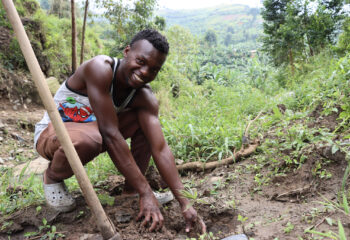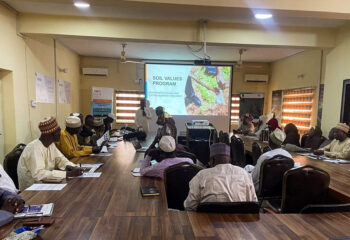
Written by Dr. Yam Gaihre, Soil Scientist, International Fertilizer Development Center (IFDC) and Dr. Shree Prasad Vista, Chief, National Soil Science Research Centre (NSSRC), Nepal Agricultural Research Council / Posted Courtesy of Halokhabar.com.
Every year, December 5 is celebrated as World Soil Day. This is the day for all soil lovers, including scientists, policymakers, students, and farmers, to talk about the importance of soils for agriculture in general and food security in particular. This day highlights the importance of soils on Earth. The soil provides a habitat for many living creatures and supports the production of foods and feeds. In December 2013, the 68th session of the UN General Assembly declared December 5 as World Soil Day. The first celebration was held in 2014. Since then, World Soil Day has been celebrated annually, with a different theme each year.
This year, World Soil Day was commemorated with the theme “Halt Soil Salinization, Boost Soil Productivity,” which aims to raise awareness on the importance of managing salinity for soil health and crop productivity. However, in the context of Nepal, soil acidity is significantly more problematic than salinity. Therefore, with the consent of the Food and Agriculture Organization of the United Nations, Nepal’s theme was modified to “Halt Soil Acidification, Boost Soil Productivity,” with the intention of raising awareness of soil acidity and its impacts on crop productivity.
In Nepal, World Soil Day featured a week-long celebration centered around different events. Celebrations were led by the National Soil Science Research Center (NSSRC) and included events such as soil testing at farmers’ fields, television shows discussing the importance of World Soil Day, press meetings, a conference on “ The Management of Soil Acidity for Prosperity,” a walkathon, and a formal closing ceremony in the presence of high government officials.
Soil acidity is one of the major issues for improving soil health and increasing crop productivity. More than 50% of soils in Nepal are acidic. Therefore, managing soil acidity is critical to increasing soil fertility and the supply of plant nutrients. Although the Government of Nepal has identified soil acidity as a major challenge in improving soil fertility, there are no comprehensive plans to correct it. In addition to natural sources such as acidic parent materials, leaching of basic cations due to rainfall and irrigation and anthropogenic activities, such as imbalanced fertilization and low use of organic inputs, are increasing soil acidity. Increasing acidity reduces the supply of plant nutrients due to reduced microbial activity; thus, it affects the mineralization of nutrients, resulting in lower crop productivity. The increased availability of micronutrients (iron, manganese, and aluminum) due to higher acidity can be toxic to plants.
Management of soil acidity is crucial for improving soil health and crop productivity. Crop productivity is relatively low in Nepal compared to other countries in south Asia. Without managing soil acidity, farmers may not be able to achieve potential yields, even after applying the right amount of fertilizers. Application of liming materials is an effective method for managing soil acidity. However, Nepalese farmers do not realize the importance of liming to improve soil fertility and increase crop productivity. Their perception is that the use of nitrogenous urea fertilizer increases yields. Moreover, liming materials are not available in sufficient quantities or in a timely manner.
In Nepal, there are only two agricultural lime industries, and there is concern regarding the quality of those liming materials.
As soil acidity is the major problem for the country’s soil fertility, the Nepalese Government should raise the awareness of farmers on correcting soil acidity and ensuring a reliable supply of quality liming materials. As most other agricultural inputs including fertilizers are subsidized, the government could provide a subsidy on liming materials as well, so that farmers give priority to using lime. There is no preexisting policy about the production and use of liming materials in Nepal. Therefore, the government may need to formulate a policy on use of agricultural lime, including its production, application protocols for different crops, and quality standards, and a design an extension campaign to raise farmers’ awareness on the use of liming materials. Research institutions should identify appropriate application rates and timing for each crop based on the severity of acidity. Once soil acidity is corrected, farmers may able to achieve crop yield potential.
In addition to the use of agricultural lime, farmers should also be advised to use sufficient amounts of organic inputs in soils, including well-decomposed farmyard manure, compost, ash, biochar, and green manure, to correct soil acidity. When there is a scarcity of liming materials, farmers can focus on adaptation strategies, such as selecting crops that can tolerate soil acidity. However, farmers are not currently aware of these options. Hence, the Government of Nepal and other development partners need to establish an awareness program for farmers.



